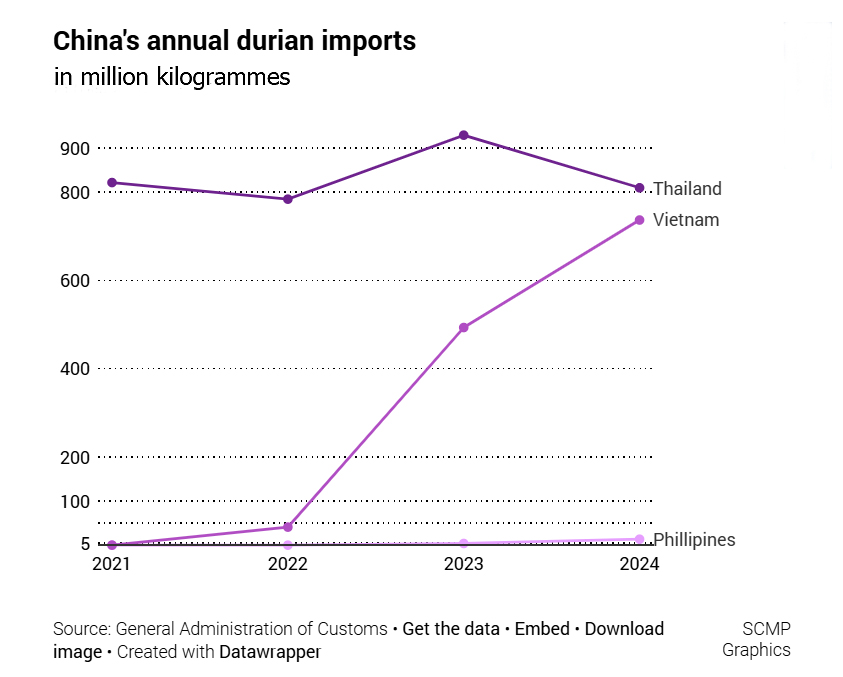Our Terms & Conditions | Our Privacy Policy
Bangkok Post – China breaks durian import record
Upstarts Vietnam and Malaysia are eyeing Thailand’s top spot
China’s durian market – the world’s largest – is becoming a battleground for countries in Southeast Asia eager to get their slice of the proceeds. (Photo: South China Morning Post)
LONDON — With China’s durian imports breaking records in 2024 – reaching nearly US$7 billion in value – competition for its market, the world’s largest, has intensified as Vietnam and Malaysia ramp up their efforts to dethrone Thailand as chief provider of the beloved tropical fruit.
According to customs data, China imported a record 15.6 billion kilogrammes of durian in 2024, up 9.4% year on year. Import value rose 4.1% to an all-time high of $6.99 billion – though this was slow compared to the explosive 66% growth rate observed in 2023 after Vietnam entered the market in earnest.
In December, China brought in almost $160 million worth of the fruit for its domestic supply – still sourced almost entirely from abroad – for a 12% year-on-year increase.
Imports of the fruit from Thailand saw a 7.6% increase year-on-year in December, despite a 12% decline last year overall for a total value of $4 billion.
Thailand has long dominated China’s durian market, accounting for 68% of imports in 2023. However, its market share in China dropped to 57% last year, a fall attributed to quality issues from the overuse of industrial plantations and a decline in production following a bout of extreme heat.
China’s General Administration of Customs mandated Thailand and Vietnam provide test reports for their durian crops after detecting excessive levels of the chemical dye Basic Yellow 2 – a known carcinogen – according to a report by Thai media outlet Bangkok Insight earlier this month. Since Jan 10, Chinese authorities have inspected random samples of the fruits at all border crossings.
Another Thai media outlet, Vision Thai, reported last week that Chinese customs had returned around 100 containers of durians shipped to the country before Jan 10, resulting in losses of 500 million baht ($14.6 million) for producers.
On Monday, Thailand resumed durian exports to China following a temporary ban on the fruit.

A woman attempts to grab a durian using a claw machine at the Food Expo, held at the Bangkok International Trade and Exhibition Centre (Bitec) in October 2024. (Photo: Somchai Poomlard)
In contrast, China’s durian imports from Vietnam – its second-largest supplier – increased by 14.6% year on year last month and 37.56% for all of 2024, amounting to $2.9 billion in value.
Despite tightening their wallets as part of a general decline in domestic demand, China’s middle class has continued to indulge in the pungent fruit, sparking competition among several Southeast Asian countries for a slice of the country’s lucrative market.
After receiving import approval for fresh durians last June and shipping its first batch to China in August, Malaysia’s exports of the fruit hit $5.7 million in value over the last five months of 2024.
China began accepting fresh durian shipments from the Philippines in April 2023. Imports from the country last year $32.5 million last year, an increase of 144.4% year on year.

Indonesia has also been lobbying for permission to export its fresh durians directly to China, aiming for its own share of a market officials estimate could reach 128.7 trillion rupiah ($7.88 billion) in size, Radio Republik Indonesia said last month.
The country’s near-feverish affection for durian has led to an explosion of promotions, themed meals and by-products to satisfy its voracious consumer base. One buffet restaurant in Shenzhen received widespread attention for a menu featuring more than 200 dishes incorporating the fruit, and particularly high-quality specimens have been given as wedding gifts.
While China has begun growing its own crop in the southern island province of Hainan to fulfil some of the demand – and keep a portion of the sizeable revenue stream within its borders – initial yields have been small, as durian trees take several years to reach full maturity.
Concerns have also been raised over the nutritional value of the home-grown product, after a recent study found a typically abundant antioxidant was missing from the domestic strain.
Images are for reference only.Images and contents gathered automatic from google or 3rd party sources.All rights on the images and contents are with their legal original owners.



Comments are closed.